
A portrait is a painting, photograph, sculpture, or other artistic representation of a person, in which the face and its expression is predominant. The intent is to display the likeness, personality, and even the mood of the person. For this reason, in photography a portrait is generally not a snapshot, but a composed image of a person in a still position. A portrait often shows a person looking directly at the painter or photographer, in order to most successfully engage the subject with the viewer.

This article refers to portraits of Vincent Van Gogh (1853–1890). It includes self-portraits, portraits of him by other artists, and photographs, one of which is dubious. Van Gogh's dozens of self-portraits were an important part of his oeuvre as a painter. Most probably, van Gogh's self-portraits are depicting the face as it appeared in the mirror he used to reproduce his face, i.e. his right side in the image is in reality the left side of his face.

Self Portrait is the tenth studio album by American singer-songwriter Bob Dylan, released on June 8, 1970, by Columbia Records.
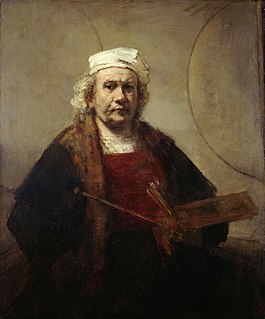
A self-portrait is a representation of an artist that is drawn, painted, photographed, or sculpted by that artist. Although self-portraits have been made since the earliest times, it is not until the Early Renaissance in the mid-15th century that artists can be frequently identified depicting themselves as either the main subject, or as important characters in their work. With better and cheaper mirrors, and the advent of the panel portrait, many painters, sculptors and printmakers tried some form of self-portraiture. Portrait of a Man in a Turban by Jan van Eyck of 1433 may well be the earliest known panel self-portrait. He painted a separate portrait of his wife, and he belonged to the social group that had begun to commission portraits, already more common among wealthy Netherlanders than south of the Alps. The genre is venerable, but not until the Renaissance, with increased wealth and interest in the individual as a subject, did it become truly popular.
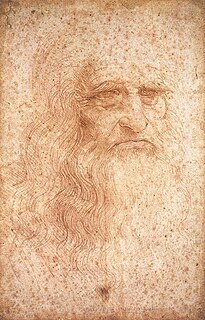
The portrait of a man in red chalk in the Royal Library of Turin is widely, though not universally, accepted as a self-portrait of Leonardo da Vinci. It is thought that Leonardo da Vinci drew this self-portrait at about the age of 60. The portrait has been extensively reproduced and has become an iconic representation of Leonardo as a polymath or "Renaissance Man". Despite this, some historians and scholars disagree as to the true identity of the sitter.

Self Portrait is an oil on canvas painting by the Dutch artist Rembrandt. Painted in 1652, it is one of over 40 painted self-portraits by Rembrandt, and was the first he had painted since 1645. In composition it is different from his previous self-portraits, depicting the painter in a direct frontal pose, hands on his hips, and with an air of self-confidence. It was painted the year that his financial difficulties began, and breaks with the sumptuous finery he had worn in previous self-portraits. Art historian Christopher White has called it "one of the most magisterial and sombre of these (late) pictures". It is in the Kunsthistorisches Museum in Vienna.

Self-Portrait with Two Circles is an oil on canvas painting by the Dutch artist Rembrandt, painted c. 1665–1669, one of over 40 painted self-portraits by Rembrandt.

Self-Portrait with Beret and Turned-Up Collar is a 1659 oil on canvas painting by the Dutch artist Rembrandt, one of over 40 self-portraits by Rembrandt. It has been noted as a self-portrayal of subtle and somber qualities, a work in which may be seen "the stresses and strains of a life compounded of creative triumphs and personal and financial reverses". Once owned by Andrew W. Mellon, it has been in the National Gallery of Art since 1937.
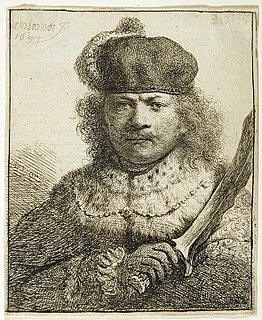
The dozens of self-portraits by Rembrandt were an important part of his oeuvre. Rembrandt created approaching one hundred self-portraits including over forty paintings, thirty-one etchings and about seven drawings; some remain uncertain as to the identity of either the subject or the artist, or the definition of a portrait.

This 1629 self-portrait by Dutch painter Rembrandt van Rijn is part of the Clowes Fund Collection of the Indianapolis Museum of Art in Indianapolis, Indiana. It is among the earliest of over 40 self-portraits by Rembrandt, which he produced over the course of four decades.

The Bootleg Series Vol. 10: Another Self Portrait (1969–1971) is a compilation album by American singer-songwriter Bob Dylan, released on August 27, 2013 on Legacy Records. The eighth installment of the ongoing Bob Dylan Bootleg Series, it consists of unreleased recordings, demo recordings, alternative takes mostly from Dylan's 1970 albums Self Portrait and New Morning, and two live tracks from the 1969 Isle of Wight Festival.

Self-Portrait at the Age of 63 is a self-portrait by the Dutch artist Rembrandt. One of three dating to 1669, it was one of the last in his series of around 80 self-portraits, painted in the months before his death in October 1669. Despite the closeness of his death, and the concentration on his aging face, Rembrandt makes an impression of a self-assured and confident artist. It was bought by the National Gallery, London in 1851.

Self-Portrait at the Age of 34 is a self-portrait by Rembrandt, dating to 1640 and now in the National Gallery in London. The painting is one of many self-portraits by Rembrandt, in both painting and etching, to show the artist in a fancy costume from the previous century. In this case specific influences in the pose have long been recognised from Raphael's Portrait of Baldassare Castiglione and Titian's A Man with a Quilted Sleeve in the National Gallery. Rembrandt saw both of these in Amsterdam, in his day the centre of Europe's art trade, and made a sketch of the Raphael, with its price.
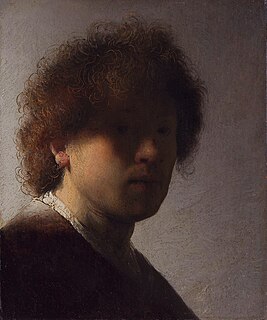
Self-portrait with dishevelled hair, Self portrait as a Young Man, and various other titles, is an early self-portrait by the Dutch artist Rembrandt, now in the Rijksmuseum. It dates to 1628 and is an exercise in chiaroscuro. It is one the earliest of over 40 painted self-portraits by Rembrandt.

The Artist as Hephaestus is a bronze statue by Sir Eduardo Paolozzi, created in 1987. It depicts a standing human figure, a self-portrait of Paolozzi 2.64 metres tall, with the left foot advanced as if walking, holding two pierced objects akin to sieves.

Dutch Post-Impressionist painter Vincent van Gogh painted a self-portrait in oil on canvas in September 1889. The work, which may have been Van Gogh's last self-portrait, was painted shortly before he left Saint-Rémy-de-Provence in southern France. The painting is now at the Musée d'Orsay in Paris.

Self-Portrait with Bandaged Ear is an 1889 self-portrait by Dutch, Post-Impressionist artist Vincent van Gogh. The painting is now in the collection of the Courtauld Institute of Art and on display in the Gallery at Somerset House.

Self-portrait without beard is an 1889 oil on canvas painting by the post-impressionist artist Vincent van Gogh. The picture, which may have been Van Gogh's last self-portrait, was painted in September that year. The self-portrait is one of the most expensive paintings of all time, selling for $71.5 million in 1998 in New York City. At the time, it was the third most expensive painting ever sold.
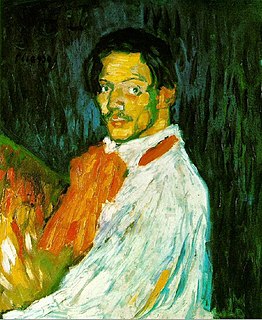
Yo, Picasso, is an oil on canvas painting by Pablo Picasso, which he painted in 1901. It is a self-portrait of the artist that depicts him in his youth, aged 19. The painting was created at the beginning of Picasso's Blue Period. On 9 May 1989, the painting sold at Sotheby's, achieving a price of $47.9 million, making it one of the most expensive paintings ever sold.

Self Portrait is a self-portrait by Tintoretto, dating to around 1588. It was bought for Marie Antoinette with the chateau de Saint-Cloud in 1785. It is now in the Louvre.


















